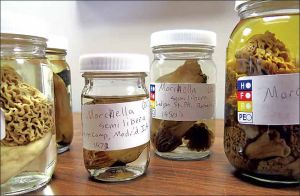
Posted: Wednesday, April 10, 2013 3:10 pm | Updated: 3:16 pm, Thu Apr 11, 2013.
Mushroom re-certification going unnoticed By Zoe Martin Iowa Farmer Today Iowa Farmer Today | 0 comments
BETTENDORF — Three years after Iowa’s morel mushroom regulations took effect, hunters throughout the state are up for re-certification to sell their wild finds.
The requirement adopted in 2010 calls for anyone selling wild morels — to restaurants, at farmers markets or to neighbors — to attend a workshop to receive certification once every three years, mirroring the model for pesticide training.
Mark Gleason, Iowa State University plant pathology professor, has been leading these workshops throughout the state.
“We cover what morels look like and what’s mistaken for morels and what happens when people eat those other mushrooms — a lot of bad things,” he said.
“If a restaurant puts morel mushrooms on the menu, somebody in the chain of supply has to be certified.”
Josh Osborn is part of that supply chain. He and his wife own Blue’s Best Mushrooms in Vinton, an operation that grows and sells Portobello, shitake and a variety of other mushrooms at farmer markets, restaurants and co-ops throughout Eastern Iowa.
So far, morels have proven impossible to domesticate. So, in the spring, Osborn and others head to the woods to hunt for their product.
Osborn attended one of the certification workshops Gleason led at the Scott County Extension Office in Bettendorf in early April.
“It’s just another requirement,” he said.
Gleason said officials from the Iowa Department of Inspections and Appeals’ Health Facilities Division randomly check up on markets and restaurants, and he’s worried some hunters don’t know about the three-year re-certification.
“That message has not sunk in,” he said. “A lot of people will be out there carrying expired licenses.”
about 350 people received training since the regulation began, Gleason said.
But, none returned to a re-certification workshop earlier this year in Altoona. about half of the 10 attendees in Bettendorf were re-certifying.
Marshall Godwin, a restaurateur in Cedar Rapids and mushroom hunter, pushed the Iowa Legislature to authorize this morel certification training three years ago.
He explained its origins while attending the workshop.
Iowa adopted the federal regulations from the FDA, he said. Before that, morels were the only mushroom that could be hunted and sold without inspection.
“When Iowa adopted this law, in the law it said they must be properly trained,” Godwin said.
“Fine and dandy, but nobody had anything set up for classes. I missed out on a year of selling to abide by the law.”
Godwin said he pressed his state senator to get training organized so direct sellers and restaurants could legally serve the morels.
The first workshop was held in the spring of 2010 at one of his restaurants, and morels were on the menu for participants.
Unlike this past year’s premature spring, when he was out hunting a month early, Osborn said he’ll begin searching for the popular fungi in May.
“We go all over Eastern Iowa, all the major parks that have a couple miles to walk in,” he said.
“You can’t find anything in the local areas that have just a 40-acre plot. Everybody wipes it out.”
Gleason said different people have different views on what makes a good season.
“When it’s cool and moist, morels come up slowly,” he said. “Opposite of a good season is hot and dry.”
Last year, some hunters were taken by surprise.
“When it gets warm quick, the season goes by quick, and some people look at the calendar and go out too late,” Gleason said.
Unlike other mushrooms that can be cultivated indoors, morels remain wild, so hunters are subject to these weather patterns.
“It’s very difficult to grow morels, people have fantasized and struggled,” Gleason said.
Osborn said he’s attempted to cultivate them with little success.
“We’ve gotten maybe two to come up inside and I’ve spent a lot of money working on it,” he said. “Waste of time really, and I just enjoy hunting them myself. . . . It gets me back in shape for the spring.”
























